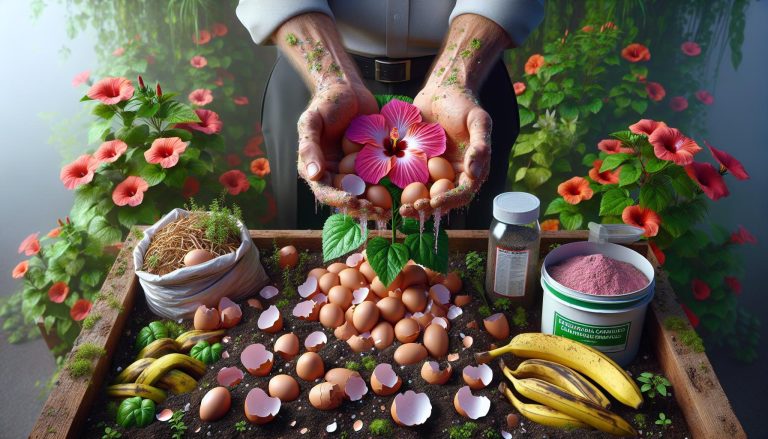Hibiscus Mutabilis – The Ultimate Guide for Gardening and Conservation
Ever marveled at the beauty of a hibiscus mutabilis? This plant, also known as the Confederate rose, is a fascinating species that’s sure to pique the interest of any gardening enthusiast. But what makes it so special?
Hibiscus Mutabilis Overview
Let’s delve deeper into the captivating world of Hibiscus Mutabilis, otherwise known as the Confederate rose. I’ll break down its origin, propagation, care needs, and the unique changes it brings with the course of the day.
The Origin of Hibiscus Mutabilis
Hibiscus Mutabilis hails from the land of China. Initially, it held a strong presence in the warmer southern parts of the country. Gradually, its popularity spread, and so did its growth zones. Today, it’s a familiar sight in gardens as far as the southeastern United States where it earned the nickname “Confederate rose”. The exact implementation of this colloquial name remains a mystery, but it’s believed to be a nod to the soil and climate compatibility between the southern US and southeastern China. It’s an exotic addition to any garden, steeped in intrigue right from its Asian roots.
Identification and Physical Characteristics

In this section, I’ll provide an in-depth look at the identifiable traits and physical characteristics of the Hibiscus Mutabilis, or Confederate rose. Our journey explores beyond the roots of this plant, enhancing your understanding of this unique garden gem.
Description of Hibiscus Mutabilis
Standing as a deciduous shrub, Hibiscus Mutabilis typically grows up to 15 feet high and 10 feet wide. It produces large, showy flowers that reach up to 6 inches in diameter. Interestingly, these blossoms change colors as the day progresses. Mornings greet gardeners with pure white petals, but as midday dominates, they blush pink — deepening into a rich rose hue by twilight.
Broad and heart-shaped, the leaves of a Confederate rose paint a tapestry of green that sharply contrasts its blooming colors. Sporting a rough texture, they’re significantly pronounced, up to 8 inches wide. In autumn, they adopt a yellow hue before dropping to the ground.
The Hibiscus Mutabilis flaunts a multi-stemmed growth habit, with stems that are woody and somewhat brittle. Though resilient, Confederate roses need a particular set of conditions to thrive, making the understanding of their features an essential step in their care.
Hibiscus Mutabilis Synonyms

I’m turning my focus to one important aspect: the synonyms of Hibiscus Mutabilis. Synonyms, in botanical terms, describe other scientific names that a plant might have been known by. Understanding them can help broaden your knowledge and aid in research.
First on the list, we’ve got Hibiscus mutabilis var. versicolor. This name refers to a specific plant variety, often distinguished by different flower colors.
Next, there’s Hibiscus mutabilis var. plenus, a term botanists use to describe the ‘double flower’ variety of Confederate rose. Double flowers present themselves as flowers within flowers, giving a more filled-out appearance.
We also encounter Hibiscus mutabilis var. albus in some botanical records. This moniker hints at a variety boasting white flowers, as ‘albus’ comes from Latin, translating to ‘white’.
Other synonyms include Hibiscus sinensis var. mutabilis and Hibiscus mutabilis f. plenus. These names might appear in older botanical texts or could be used by botanists from different regions worldwide.
You might come across Hibiscus mutabilis var. versicolor f. plenus in your research as well. This nomenclature indicates a variant with characteristics of both versicolor and plenus—possibly varying color themes and fuller blooms.
Finally, considering the historical context, Confederate rose had been referred to as Hibiscus mutabilis var. mutabilis. This term communicates the ‘type’ variety, which displays the species’ most common and distinguishing characteristics.
By acknowledging these synonyms, you reinforce your understanding of the Hibiscus Mutabilis, round out research capabilities and gather a more comprehensive view of this interesting plant species. Remember, all these names hold equal validity — they’re simply different ways of referring to our plant at hand, the Hibiscus Mutabilis, or as commonly known, Confederate rose.
Cultural Significance of Hibiscus Mutabilis

Following our exploration of the numerous names of Hibiscus Mutabilis, it’s equally crucial to delve into its cultural significance. Revered across various cultures and regions, this plant isn’t merely a botanical specimen; it boasts a rich cultural footprint.
In eastern Asian traditions, Hibiscus Mutabilis finds a notable place. In Chinese culture, it’s celebrated as ‘Fu Sang,’ representing the east and the rising sun. Equally, in Vietnam, the plant’s called ‘Bông sữa,’ symbolizing mother’s love, as its petals change color throughout the day, akin to a mother’s unending care.
Next, let’s shift focus to the southern states of the United States. Here, Hibiscus Mutabilis, known as the Confederate rose, holds historical relevance. Its name stems from a Civil war tale, but over time, people have come to love its impressive blooms and resilient nature.
Lastly, look towards the Pacific – in Tahiti and Hawaii. Uses of Hibiscus Mutabilis, or ‘Pua aloalo’ in Hawaiian, extend beyond the aesthetic. Traditional medicinal practices leverage it as a remedy for several ailments. Notably, it’s Hawaii’s state flower, manifesting its cultural impact.
Hibiscus Mutabilis, blurring geographical boundaries, continues to showcase rich cultural significance worldwide. It’s not just a plant; it’s an integral part of people’s lives and traditions.
Growing Hibiscus Mutabilis
Transitioning from its cultural importance, let’s delve into the requirements for growing Hibiscus Mutabilis. Cultivation of this plant demands consideration of several factors including soil type, light conditions, and watering, temperature, humidity, and fertilization needs.
Types of Soil for Hibiscus Mutabilis
Well-draining soil spells success for growing Hibiscus Mutabilis. Sandy-loam or clay-loam soils, on PH balance slightly acidic to neutral (around 6 to 7). These soils drain excess water efficiently, a crucial factor since Hibiscus Mutabilis isn’t a fan of water-clogged roots.
Ideal Light Conditions
For Hibiscus Mutabilis, sunlight moderation rules. Bright, indirect light optimizes growth, and six to eight hours of filtered sunlight daily ensures abundant blooming. Direct, intense sunlight can, in contrast, cause leaf burn.
Watering Requirements
Hydration for Hibiscus Mutabilis walks a tightrope between adequate and excessive. Sufficient watering means keeping the soil moist, especially during dry spells, but ensuring it doesn’t get soggy. Overwatering leads to root rot, while underwatering results in wilted leaves.
Optimum Temperature and Humidity
Versatility characterizes the Hibiscus Mutabilis’ temperature preferences. It thrives in temperatures ranging from 60°F (15°C) to 90°F (32°C). Humidity-wise, it’s dynamic – it handles the moisture-rich climate of its native tropics as well as it does the drier conditions of temperate zones.
Fertilization Needs
For Hibiscus Mutabilis, fertilization forms a key part of its growth strategy. A balanced fertilizer, like a 10-10-10 or a 15-15-15 blend, applied every two weeks during growing season propels its growth. In non-growing months, a little goes a long way with only monthly application needed. The plant prefers slightly acidic environments, so avoid using high alkaline fertilizers.
Propagation Methods for Hibiscus Mutabilis
Coming from the same hibiscus family, Hibiscus Mutabilis, it’s no surprise that propagation techniques for this species are quite similar to its kins. Two primary methods stand out – stem cuttings and seeds.
Propagation via Stem Cuttings
Taking stem cuttings emerges as the most prevalent method in the propagation process. To propagate Hibiscus Mutabilis through stem cuttings, selecting healthy, disease-free plants is essential. Follow these steps:
- Identify healthy, non-woody stems, about 4-6 inches in length, for the cutting process. Examples include the ones growing off the main stem.
- Remove leaves at the base of the cutting, as they’d retain essential water otherwise required by the plant.
- Dip the cutting’s base in rooting hormone. This enhances the growth rate of roots, leading to a sturdy plant.
- Place cuttings in a container filled with well-draining potting soil, with constant temperatures between 60°F and 70°F. A key factor here is adequate humidity without waterlogging conditions.
- After 4 to 6 weeks, once the roots start developing, re-pot the young plant, ensuring a nutrient-rich soil mix.
Using stem cuttings retains genetic similarity between the parent and offspring plant; if the parent plant exhibits certain desirable traits, they’ll likely pass on to the offspring.
Propagation via Seeds
Planting Hibiscus Mutabilis seeds is another way to propagate this versatile plant. Here’s how:
- Collect ripe seeds from the flowers after the hibiscus’s blooming season, typically autumn.
- Store seeds in a dry, cool place until late winter or early spring.
- Prior to sowing, soak the seeds in water for approximately an hour. This prepares them for germination.
- Sow the seeds in well-draining soil, maintaining consistent moisture but avoiding waterlogging.
- Usually, seeds germinate within a couple of weeks, though patience is essential. Once the seedling grows its second pair of true leaves, transplant it to its permanent location.
The takeaway is, whether it’s stem cuttings or seeds, attention to detail plays a critical part in successfully propagating Hibiscus Mutabilis. Both methods have their merits, with the final approach narrowing down to personal preferences and necessities. It’s all about finding one’s rhythm – as the stride hits, the beauty of Hibiscus Mutabilis springs to life.
How to Grow Hibiscus Mutabilis from Seed
Growing Hibiscus Mutabilis from seed involves a series of steps that drive success. Let’s break them down:
- Seed Collection: Gather ripe seeds from mature Hibiscus Mutabilis plants. Mature seeds portray dark coloration and a dry, somewhat furrowed texture. Keep these in a cool, dry space to preserve them, away from sunlight, dampness, and pests.
- Seed Preparation: Immerse seeds in water for 24 hours. This soaking phase assists the hard seed coat in becoming permeable, a hardiness acquired through evolutionary measures for plant survival. Discard any seeds that float; they’re non-viable.
- Sowing the Seeds: Prepare a seed tray with well-draining soil. Perlite, vermiculite, or a mixture of both suit the affair. Space the seeds evenly, avoiding overcrowding. Covering them lightly with soil stays conducive.
- Suitable Environment: Hibiscus mutabilis seeds appreciate warmth. Maintaining a temperature around 70 to 75 degrees Fahrenheit propels germination.
- Watering: Keep a balanced moisture level; consistently moist, never waterlogged. Watering from below, using a tray, reduces surface evaporation and ensures better absorption by the seeds.
- Germination: Patiently wait for germination, which typically happens within 2 to 4 weeks.
- Transplanting:Once the seedlings harbor a few true leaves, my best advice entails transplanting them to individual pots with high-quality potting soil, further propelling their growth journey.
Through this method, not only does one get to experience the marvel of botanical life unfolding but also warrants a garden graced by Hibiscus Mutabilis. Always remember, respect for the plant’s natural rhythm and patient adherence to these steps yields fruitful blooming outcomes.
Pruning Techniques for Hibiscus Mutabilis
After successfully propagating and nurturing the Hibiscus Mutabilis, it’s natural to want it to grow and flourish. Pruning it becomes a necessity, as this action contributes significantly to the plant’s health and aesthetic appearance. Pruning Hibiscus Mutabilis optimizes growth, guarantees lush foliage, and promotes the abundant blossoming the plant is known for.
Determine the Right Time
While pruning can generally be done at any time, it’s key to target late winter or early spring for this task. This is when the plant is dormant, and the risk of inadvertently causing damage is lowered. The previously mentioned period leads right into the growing season, giving the plant ample time to recover and thrive post-pruning.
Select the Right Tools
For pruning Hibiscus Mutabilis, one typically needs a pair of hand pruners for smaller branches and loppers for larger ones. It’s essential that the tools are clean and sharp, preventing disease spread and minimizing plant stress by making clean cuts.
Identify the Parts to Prune
In Hibiscus Mutabilis, start with the 3 Ds: Dead, Damaged, and Diseased branches. These are detrimental to the overall health of the plant and might cause harm to the remaining portions. It’s equally important to watch out for any branches that cross or rub against each other, as these can open wounds on the plant, making it susceptible to infections.
Execution of the Pruning
A proper pruning technique involves making a cut at a 45-degree angle about 1/4 inch above a bud that is facing the outside of the plant. This direction promotes outward growth, which helps maintain the plant’s natural shape and avoids crowding in the center.
Remember, Hibiscus Mutabilis tolerates heavy pruning, but make sure not to remove more than one-third of the plant in a single pruning session. This keeps the plant strong, reduces stress, and allows the Hibiscus Mutabilis to bounce back with renewed vigor and luscious blooms.
Post-Pruning Care
Once the pruning session concludes, give the plant a bit of TLC by watering it thoroughly. This replenishes the moisture lost during the process. Should there be visible cuts on the plant, consider applying a fungicide or natural wound sealant to protect against disease-causing organisms.
In this regard, Hibiscus Mutabilis delivers an optimal gardening experience, proving its resilience, beauty, and the pleasure gained from caring for it. Pruning, after all, becomes an extension of this enriching experience, testifying to the plant’s unyielding growth and captivating bloom cycle. Enjoy the process, and witness the rejuvenating impact it has on your Hibiscus Mutabilis.
Overwintering Tips for Hibiscus Mutabilis
As we transition from topics of pruning and care in previous sections, it’s important to share some critical tips for overwintering Hibiscus Mutabilis. Known for its resilience, this plant still requires some special measures during the winter months.
- Ensure Adequate Sunlight: Even during winter, Hibiscus Mutabilis needs at least six hours of sunlight daily. According to the United States Department of Agriculture, placing the plant near a south-facing window often does the trick.
- Manage Temperature Levels: Hibiscus Mutabilis thrives in temperatures between 60°F and 75°F. Keeping the plant indoors during frosty weather maintains this temperature range, ensuring its healthy survival.
- Adjust Watering: Overwatering during winters can lead to root rot. Water the plant only when the top inch of the soil feels dry to the touch.
- Protect from Drafts: Cold drafts, especially from windows and doors, can harm Hibiscus Mutabilis. It’s best to position the plant away from direct drafts.
Let’s delve deeper into these categories.
Ensure Adequate Sunlight
Sunlight plays a crucial role in maintaining the health of Hibiscus Mutabilis, even during winter. The plant generally requires around six hours of sunlight each day (USDA, 2020). During winter, place it near a south-facing window for optimal sunlight exposure.
Manage Temperature Levels
Temperature regulation is another critical aspect of Hibiscus Mutabilis overwintering. The plant prefers temperatures between 60°F and 75°F (NCSU Extension, 2018). When temperatures drop below this range, consider moving the plant indoors where it can stay warm.
Adjust Watering
Overwatering in winter is a common mistake. Wait to water until the top inch of soil feels dry to your touch (UGA Extension, 2019). This practice helps to prevent root rot and other water-related issues.
Protect from Drafts
Cold drafts can be detrimental to Hibiscus Mutabilis. Position it away from windows, doors, and other sources of drafts to maintain a consistent temperature (Clemson University Home & Garden Information Center, 2017).
With these overwintering tips in mind, your Hibiscus Mutabilis is positioned to bloom heartily once springtime arrives. At each stage, from ensuring sunlight and temperature regulation to adjusting watering schedules and protecting your plant from drafts, the focus is on maintaining your Hibiscus Mutabilis’s optimal health.
Common Problems with Hibiscus Mutabilis
Healthy Hibiscus Mutabilis plants require careful observation and prompt problem-solving. Let’s consider some common difficulties and their respective solutions.
Dealing With Leaf Curling
Leaf curling in Hibiscus Mutabilis usually signifies stress from inconsistent watering practices or active pest presence. To deal with curling, ensure consistent watering routines, never soaking or drying out the soil entirely. It’s about achieving a balance. In case of pests, sprays like neem oil can be effective.
Addressing Yellow Leaves
Hibiscus Mutabilis may exhibit yellow leaves due to overwatering, insufficient nutrients, or inadequate sunlight. To address this, firstly reduce the watering frequency. Check if the sunlight exposure meets the plant’s requirement — 6 to 8 hours per day. Lastly, incorporate a slow-release, high-potassium fertilizer into the soil regularly.
Solutions for Drooping Leaves
Drooping leaves often indicate inadequate watering — either too much or too little. Start by analyzing the plant’s watering schedule. If it’s being overwatered, reduce the frequency. For underwatering situations, increase it. Understanding your plant’s water needs is instrumental for its overall vitality.
Remedies for Falling Plant Leaves
Excessive leaf drop is generally a sign of sudden temperature changes, which Hibiscus Mutabilis is sensitive to. If this is the case, adjust your plant’s location according to the season to maintain a consistent temperature. Occasional leaf drop, however, is normal and no cause for alarm. After all, maintaining a thriving Hibiscus Mutabilis involves troubleshooting but also recognizing common plant behaviours.
Getting Hibiscus Mutabilis to Bloom
Having understood the cultural significance and care essentials for Hibiscus Mutabilis, or Confederate rose, let’s venture into tips for promoting profuse blooms in the plant. Although Hibiscus Mutabilis requires a regimen of special care to flourish, getting it to bloom isn’t as challenging as it seems with the right strategies in place.
Choosing the Right Soil
Hibiscus Mutabilis craves a well-draining soil, which aids in preventing root rot and related plant diseases. For optimal growth, opt for loamy or sandy soil, rich in organic matter, to keep the root system healthy.
Maintaining Optimal pH Levels
pH level, the measure that determines how acidic or alkaline the soil is, matters to Confederate rose. Hibiscus Mutabilis prefers slightly acidic soil, ideally with a pH range of 6.0 to 6.5. One can easily measure soil pH using a home testing kit.
Correct Watering Regimen
While Hibiscus Mutabilis tolerates dry spells, it prefers a consistent watering schedule. Overwatering can lead to root diseases, while underwatering may cause the plant to wilt and prevent blooming. Monitor the soil’s moisture level and water adequately to keep it evenly damp without drowning the plant.
Providing Sufficient Sunlight
Though Confederate rose can survive in partial shade, it thrives when it receives full sunlight – at least six hours daily. Full sunlight exposure triggers the plant’s blooming cycle, resulting in vibrant, eye-catching flowers.
Using the Right Fertilizer
Fertilizer application boosts the plant’s vigor and flowering. Using an organic, slow-release fertilizer high in potassium and phosphorous will aid Hibiscus Mutabilis in producing more blooms.
Following these tips will ensure your Hibiscus Mutabilis plants give you a beautiful display of changing colors in their blossoming season. From soft pink to deep red, delight in the wonder of nature’s transformation in your own garden.
Edible Uses of Hibiscus Mutabilis
Hibiscus Mutabilis, often referred to as the “Confederate rose,” not only offers aesthetic value but also provides edible elements. While nurturing and caring for this plant contributes to an attractive landscape, an added benefit lies in the consumption of its certain parts.
Leaves as a Vegetable
The versatile leaves of the Hibiscus Mutabilis serve culinary purposes. People often consume them as a vegetable. I find that they make a nutritious addition to stir-fries, soups, and stews, thereby boosting their dietary fiber content.
The Nutritious Flower
The big, showy flowers of Hibiscus Mutabilis are not just for display. They also form a healthy, edible part. Rich in essential vitamins and minerals such as Vitamin C, they can be eaten raw in salads or used in the preparation of jellies and teas, providing a tangy flavor and vivid color.
Lesser-Known Edible Parts
Apart from leaves and flowers, other parts of Hibiscus Mutabilis like buds and shoots also tend to be edible, albeit lesser-known. These parts commonly find their way into Asian cuisines, lending a unique taste and texture to an assortment of dishes.
Overall, the edible uses of Hibiscus Mutabilis extend beyond its leaves and flowers, bringing versatility to both your kitchen and garden. They offer you a combination of beauty, taste, and nutrition, thus reaffirming that this plant’s gifts extend well beyond its famed subtle, color-changing blossoms.
Medicinal Uses of Hibiscus Mutabilis
Building upon Hibiscus Mutabilis’s versatile role in the kitchen and garden, this plant boasts an impressive list of medicinal benefits as well. As is evident from traditional medicine practices, this robust and ornamental garden staple offers an array of health-enhancing properties.
Notably, Hibiscus Mutabilis is revered for its antipyretic properties. This indicates its ability to reduce high body temperature, a healing aspect invaluable in treating feverish conditions. Accompanied by its ability to promote sweating, Hibiscus Mutabilis can effectively enhance the body’s natural cooling processes.
Furthermore, it’s recognized for its antimicrobial abilities. Making use of its leaves or flowers can produce a potent compound that combats various pathogenic agents including bacteria and viruses. Given the increasing instances of microbial resistance, the significance of natural antimicrobial solutions like Hibiscus Mutabilis can’t be understated.
Importantly, viewers can utilize this plant to address issues of hypertension. Regular intake of Hibiscus Mutabilis has shown to regulate blood pressure. It does this by relaxing the smooth muscles of the vessels, an effect that enhances the overall blood circulation. Consequently, this lowers the risk of cardiovascular diseases—such as strokes and heart attacks—notably improving overall heart health.
Lastly, Hibiscus Mutabilis contributes positively to mental health. It’s evident that consuming this plant’s extracts can ameliorate symptoms of nervous disorders, including anxiety and depression. The calming and sedative nature of these extracts plays a pivotal role in managing such conditions, fostering a sense of mental well-being.
Always remember, though Hibiscus Mutabilis offers numerous health benefits, consulting a healthcare professional before initiating any natural therapeutic regimen is critical. So, next time you’re pruning or cooking with Hibiscus Mutabilis, appreciate this plant’s wide-ranging therapeutic potential.
Biological Threats to Hibiscus Mutabilis
A critical part of any plant’s care regimen is addressing potential biological threats. Hibiscus Mutabilis is no exception and faces its share of challenges in the form of pests, diseases, and weed potential.
Pests & Plant Diseases
The Hibiscus Mutabilis, like any vigorous plant, has its share of adversaries. Notably, insects such as aphids, whiteflies, and mealybugs can distress this plant species. While they can cause considerable harm by sucking sap from the undersides of leaves, the use of organic insecticides proves effective in handling such issues.
Besides insects, the Confederate rose can also suffer from fungal diseases like powdery mildew – a white, powdery fungus that affects the leaves, stems, and flowers in damp, warm conditions. A robust approach to mitigating this usually involves reducing overcrowding, avoiding excess watering, and applying an organic fungicide if necessary.
The plant may also encounter bacterial leaf spot, a condition characterized by small, brown, sunken spots on the leaves. Combat this by adopting good hygiene practices, such as disinfecting tools and removing affected plant parts immediately.
Remember, early detection and prompt response can minimize damage and safeguard your Hibiscus Mutabilis’s health.
Weed Potential
It’s important to note that while Hibiscus has considerable aesthetic and cultural significance, its resilient nature can sometimes lead to uncontrolled growth, becoming invasive in certain conditions. For instance, in some parts of Australia, the Hibiscus Mutabilis has ‘naturalized,’ growing freely and competitively among native plants, demonstrating weed potential.
Discouraging its growth beyond the desired areas involves regular monitoring and prompt removal of any excess plants. Use garden tools and techniques like pulling or digging to control the spread. Keep in mind that maintaining a balance is vital to ensure your garden’s overall health and harmony without compromising the charm of the Hibiscus Mutabilis.
Conservation Status of Hibiscus Mutabilis
Building upon our earlier discussion about the potential threats to Hibiscus Mutabilis such as pests, diseases, and unmonitored growth, the conservation status of this versatile plant comes into focus. The Confederate rose, unlike some other species of its genus, doesn’t teeter on the brink of extinction. Unlike its native habitat in the southeastern part of China, where it’s a common sight, the plant’s status fluctuates in different parts of the world; conservation measures, therefore, vary correspondingly.
Categorically, Hibiscus Mutabilis isn’t on any global endangered lists. Acknowledging its wide cultivation in public and private gardens, combined with an ability to self-seed and potentially invade natural habitats, the rumination of it joining the endangered list seems unlikely.
Consequently, Hibiscus Mutabilis doesn’t receive the same focused attention, in terms of preservation efforts, that endangers plants do. It’s the responsibility of cultivators and gardeners to ensure that this plant doesn’t become invasive, particularly in regions outside its original native domicile.
But keep in mind, the lack of immediate threat to Hibiscus Mutabilis shouldn’t diminish the importance of its conservation. Cultivators and gardeners must consider the balance between growth and control in order to maintain the healthy presence of this plant.
Parallel to its maintenance in personal gardens, Hibiscus Mutabilis finds itself a participant in broader conservation efforts. These include the establishment and preservation of protected natural habitats, educational campaigns about responsible plant propagation, and a regulatory overview of its commerce.
In layman’s terms, while Hibiscus Mutabilis isn’t globally endangered, maintaining its healthy propagation signifies an important task for individual plant enthusiasts, and in a wider perspective, for conservation societies. It’s indispensable to remember that preservation starts at home; yet, in the larger sense, it entails the participation and collaboration of the global community.
Conclusion
So there you have it. The Confederate rose, or Hibiscus Mutabilis, isn’t just a pretty face in the garden. Its cultural significance, versatility, and the wealth of benefits it offers make it a plant worthy of our attention. As growers and gardeners, we’ve got a role to play in its conservation. It’s not about just letting it grow, but doing so responsibly to prevent invasiveness. We can enjoy its profuse blooms, make use of its edibility, and tap into its medicinal properties, all while ensuring its healthy propagation. It’s a delicate balance, but it’s one we should strive for. After all, the beauty and benefits of the Confederate rose are too significant to ignore. Let’s do our part to preserve this incredible plant.






